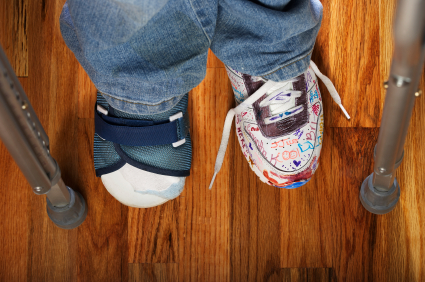 The teen-age soccer player's mom sounded worried on the phone. Her son had just played three tournament games in a row and could barely walk off the field. The soccer player's coach had asked if he wanted to sit out, but he said no. "The child's just trying to perform, so he's not listening to his own body," says Bellevue chiropractor Diane Hughes, D.C., who talked to the worried mom.
The teen-age soccer player's mom sounded worried on the phone. Her son had just played three tournament games in a row and could barely walk off the field. The soccer player's coach had asked if he wanted to sit out, but he said no. "The child's just trying to perform, so he's not listening to his own body," says Bellevue chiropractor Diane Hughes, D.C., who talked to the worried mom.
Hughes and other health care professionals are noticing the same disturbing trend -- an increase in the number of teenagers who are injuring themselves playing the sports they love. "Two weeks ago I saw a 14- or 15-year-old with a stress fracture," says John O'Kane, M.D., of the University of Washington. "She's trying to play club soccer, high school soccer and running track. Some days she is literally running for four, five, six hours a day.
O'Kane, head team physician for the UW athletic department and associate professor of orthopedics and sports medicine at UW Medical School, says the evidence is anecdotal but persuasive. "If you talk to doctors who treat these injuries, they all say they're seeing more injuries in younger kids; they're seeing more overuse injuries and they're seeing more serious injuries," he says.
A major problem is increased opportunities for playing one sport year round. Teen athletes have no time to rest and they're overusing the same muscle groups.
Playing baseball in the fall after a long spring and summer season is a good example, says Dan Potts of Advanced Athlete Strength Training in Lake City. "The kid would be better off body surfing with his family in Hawaii or playing another sport," Potts says.
Another issue is the trend toward high-level coaching for younger players. O'Kane says coaches would do well to pay attention to a cardinal rule of physicians who treat kids. "When you're training kids, they're not little adults," he says. "You can't put them through the same rigorous program."
One injury risk unique to kids is their open growth plates, O'Kane says. An untreated injury to the growth plate can cause it to stop growing, doing permanent damage. Many more girls than boys hear that terrible "pop," which can mean an injury to the ACL (anterior cruciate ligament), a stabilizer in the knee joint, according to Gregory Schmale, M.D., attending physician at Children's Medical Center. The reason is unclear but theories include girls' physiology or hormonal make-up. Studies are underway to determine if strengthening the hamstring muscles will help girls avoid injury.
Working on flexibility and conditioning before the sport season starts can help prevent injuries. Potts' program, for example, involves balancing and stabilizing the body to make it more functional. "I tell them that after age 13, the single most important component is their strength work," he says. "The coaches are going to have them on the field 13 months a year. Their only protection is how functionally strong they are."
Medical professionals agree that it's up to the parents to help guide these teen athletes through a safe season. Schmale, who also serves as assistant professor at the UW School of Medicine in the orthopedics and sports medicine department, recommends that parents meet their kids' coaches and explore the following issues: Experience. Does the coach have experience coaching the sport your child is playing? Emergency preparation.
What about first-aid training? Is there a team medical kit that contains more than Band-Aids and a plan of response if someone gets injured?
Organization. Are kids of the same age and size playing against each other? Are the fields or courts safe and in good playing condition? Are practices scheduled outside the heat of the day?
It's also important to make sure your child is prepared for the sport. Parents should accompany their young athlete to his or her sports physical to provide a thorough health history, Schmale says.
In addition, pay attention to: Good hydration and nutrition. "What you eat, digest and absorb becomes part of your body," Hughes says. "You need fuel; you need to understand that." Rest and recovery time.
All kids need downtime for their bodies to recover from competition. If your teen is a young pitcher, monitor the minutes of play and the pitch counts, not just during competition, but also at practice and at home. (See related story at www.parentmap.com/sportsinjuries13-18.) Signs of burnout.
Schmale says he finds that most of the pressure to play comes from the young athlete. But O'Kane has noticed another phenomenon -- the kid who turns up injured because he wants to quit playing.
"It's one of the things parents need to look out for," he says. "Is this the kids' way of trying to tell their parents they don't want to play anymore?" Area experts agree that parents are their kids' best defense against the pressures of what has become a hyper-competitive sports environment. "As a society and as parents, we've got to try to take this back," Potts says. "You can't be competitive to the point you're damaging a kid's self esteem and his body."
Freelance writer Elaine Bowers lives in Seattle with her husband and twin teen-age daughters. Advice for parents of young baseball pitchers Increasing instances of overuse injuries in teen athletes are setting off alarm bells among medical professionals.
More high school pitchers, for instance, are opting for Tommy John surgery. Once performed only on college and professional players, the elbow reconstruction surgery was named after former big league pitcher Tommy John, who first had the surgery 30 years ago. A study published in the American Journal of Sports Medicine showed a significant relationship between the number of pitches thrown and the risk of shoulder and elbow pain in youth baseball. The American Sports Medicine Institute recommends that 13- to 14-year-olds throw no more than 76 pitches in a game. That number is increased to 91 pitches for 15- and 16-year-olds and 106 pitches for 17- and 18-year-olds. Experts say kids should reach their pitch limit no more than twice in a week.











